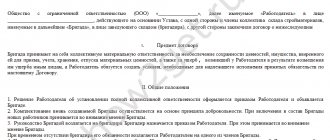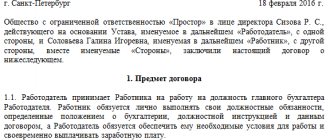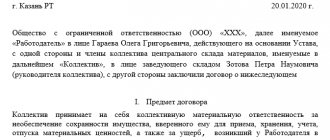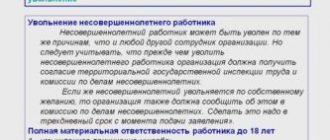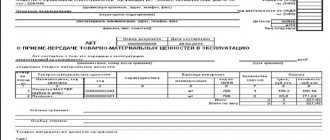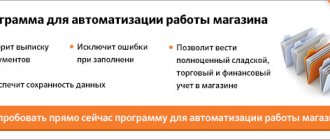When is an agreement on full collective financial responsibility drawn up?
An agreement on collective liability (CLL) is concluded to determine the scope and boundaries of the responsibility of a collective of workers related to ensuring the safety of the company’s property. In addition to these issues, the text of the DKMO is supplemented with a damage compensation scheme, taking into account the degree of guilt of each member of the team.
IMPORTANT! Registration of the DKMO is provided for in Art. 245 of the Labor Code of the Russian Federation, its subject is collective financial responsibility, which arises when it is impossible to outline the boundaries of responsibility of each employee when performing work together.
A conclusion with the DKMO team is required when employees perform joint work related to the storage, processing, sale (release), transportation, use or other use of valuables.
IMPORTANT! Before concluding the DKMO, it is necessary to check the list of works specified in the Decree of the Ministry of Labor of the Russian Federation dated December 31, 2002 No. 85. If it does not include the type of work performed by the team, execution of the DKMO is meaningless (the contract will not have legal force).
Labor legislation very succinctly outlines the format of the Labor Code of Labor - a mandatory written form and a specific list of the team (team). At the same time, the company must have employment contracts drawn up with all team members.
“Unified Form No. TD-1 - Employment Contract” will help you formalize labor relations with employees .
In other words, employees whose names are named in the DKMO are responsible to the employer for the safety of the property entrusted to them and are obliged to compensate the cost if it is lost or damaged. A team member can avoid negative material losses due to compensation for damage only in one case - if he proves that he is not to blame for the loss or damage to the company’s assets.
https://youtu.be/Hw25fktKVK4
Compilation rules
An agreement on collective financial responsibility is a document that is drawn up in addition to the employment contract. It can be concluded along with it, as well as later, when employees become financially responsible.
Let's look at how collective liability is drawn up; the contract has basic rules .
Firstly, this is an employment relationship, which is concluded in writing between employees and the employer on compensation to the latter for material losses.
Concluded only with employees who are over 18 years old .
And they actually use and maintain the values that are the subject of the contract.
Secondly, the agreement on full collective brigade liability is concluded voluntarily with all members of the work collective.
Thirdly, the collective brigade agreement on material responsibility must indicate the material assets for which the team is responsible.
Fourthly, in order to relieve liability from any employee, he must prove his non-involvement in the loss .
Fifthly, if damage caused by the fault of the team is compensated voluntarily by the employees, then the amount of compensation is set jointly by the employees . If, if one of the employees disagrees, a trial is necessary, then the amount of compensation is already established by the court .
Sixthly, an agreement on material team responsibility must be signed by each employee to whom it is assigned.
What is included in the KMO and what is its content?
How to correctly compile a KMO? What form of agreement on collective liability must have, and what is optional?
Reference ! Before concluding such an agreement, it is necessary to elect a leader (foreman) of the team (team) at a general meeting.
- Subject of the agreement. Here it is precisely stipulated that the collective takes upon itself responsibility for safety property entrusted to him. And for what may happen to him (to the property).
For example, valuables may be damaged or lost by other persons, but through the fault of employees.And the employer, in turn, undertakes to provide the team with the conditions necessary for the proper fulfillment of the obligations specified in this document.
- General provisions . In this part, it is necessary to indicate with whom the agreement on full collective financial responsibility of the employee is concluded, who is entrusted with management, what to do if the foreman (manager) is absent, and who will replace him at this time.
Also stipulate the terms and conditions for re-concluding the contract. A new collective liability agreement can be concluded if its leader leaves the team or more than half of the employees leave/arrive. In other cases, it is not re-signed, and new arrivals or departures are included in the list or the date of departure from the team is indicated. - Rights and obligations team (team) and employer. Here it is necessary to include clauses that exclude various legal risks.
- employees undertake to protect the property that they have been entrusted with for the performance of their professional duties. If any circumstances arise that may threaten the safety of valuables, immediately report this to management. Keep timely records, provide the employer with reports on inspections carried out on time and participate in audits and inventories carried out by the organization’s management and other bodies;
- the employer , in turn, undertakes to create for the team the conditions that are necessary for full-fledged work activity and the safety of the property for which this team is responsible. He is also obliged to promptly familiarize his subordinates with all the standards, acts, regulations, procedures of the company, to conduct timely audits and other various checks of the condition and availability of valuables in the manner prescribed by law.
- The procedure for maintaining accounting records . This paragraph stipulates what types of inventories will be carried out, how the result of the inspection will be recorded, and how it will be communicated to the team.
- Compensation for damage.
Here it is worth discussing how the procedure for compensation for material damage will be regulated.Naturally, this procedure should in no way contradict the legislation of the Russian Federation.
- Signatures of the parties . This paragraph indicates the addresses and signatures of the parties. On the employer’s side – its name, legal address and details, and on the team’s side – full name, position and address of the team leader (foreman).
Let us repeat once again that the agreement on full collective financial responsibility (a sample can be downloaded at the end of the section) must be signed by all responsible employees voluntarily .
This concerns the mandatory items. Also, in KMO, at the request and agreement of the parties , it is possible to include responsibility for non-essential material resources necessary for the implementation of activities (consumables, household goods, office, equipment).
Team financial responsibility: agreement, sample.
General and mandatory points of the DKMO
General (managerial) aspects of the operation of the DKMO are reflected in a separate section and include the following:
- compliance with the principle of voluntariness when forming a team;
- appointment of a foreman taking into account the opinion of the team;
- assignment of duties to a temporarily absent foreman;
- an unconditional requirement to re-conclude the DKMO when the team changes by 50%;
- entering additional information into the DKMO, which does not lead to its re-conclusion, upon the admission or departure of its members from the brigade.
An important part of the DKMO is the section on the rights and obligations of the parties to the agreement. The team and the employer are subject to a set of mandatory procedures, which can be grouped into 3 groups:
- the team is obliged to ensure the safety of the entrusted property, and the employer is obliged to organize the necessary conditions for this;
- the team is obliged to promptly inform management about cases that threaten the safety of property, and the employer is also obliged to promptly influence their elimination;
- the foreman must monitor the movement and take into account the balances of the entrusted assets, as well as report on this, and the employer must provide appropriate conditions for this.
In addition to those indicated, the employer is assigned 2 additional groups of responsibilities:
- provide the team with up-to-date information about current legislation in the field of liability, regulatory nuances of the procedure for storage and other operations with property;
- take into account the opinion of the brigade in various issues related to the formation of the brigade, or when considering the validity of requests for an inventory of assets entrusted to the brigade.
Learn the nuances of conducting and registering an inventory in the materials posted on our website:
- “Inventory order - sample filling”;
- “Unified form No. INV-3 - form and sample”.
The same section of the DKMO establishes the rights of the brigade - we’ll talk about this later.
Release of an employee from collective financial liability
According to.
3 tbsp. 245 of the Labor Code of the Russian Federation, an employee who has signed an agreement on collective financial responsibility, if there are appropriate grounds, may be released by the court from paying off damages to the employer, but the obligation to prove his innocence in causing damage to the employer or his property lies entirely with the employee himself. The employee’s obligation to prove his innocence was confirmed in its Decision of June 24, 2008 No. 349-О-О by the Constitutional Court of the Russian Federation “On the refusal to accept for consideration the complaint of citizen B.E.V. for violation of her constitutional rights by part three of Article 245 of the Labor Code of the Russian Federation.”

